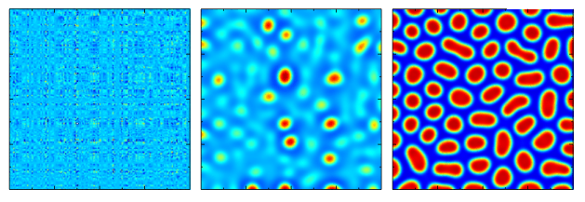Animal Stripes for Camouflage
February 18, 2016
Mathematician,
Alan Turing (1912-1954), who was born a little more than a hundred years ago, is known for his work on many early computer science problems. One of the easiest to understand is the
Turing test, which is a test of a computer's ability to
mimic intelligence. "Intelligence" in this case is human intelligence, so a computer program must mimic human
ignorance as well as human intelligence to pass the test.
In 1936, Turing developed a
model of an ideal
computer that's now called the Turing machine. This computer functions by just reading and manipulating symbols on a tape according to a table of rules. Turing used his machine to solve the problem of whether an arbitrary computer program will finish its computation, a problem known as the "
Halting problem."
Such a problem is one of a type called an Entscheidungsproblem in deference to David Hilbert, the German mathematician who introduced it. Turing showed that
it can't be decided by a general algorithm whether a computer program will ever complete.
The portion of Turing work that most people would associate with computers was done during
World War II, when he built
electromechanical computers to do cryptanalysis of secret messages at the British Bletchley Park facility. He also collaborated on a method, called
Good–Turing frequency estimation, to estimate the probability of finding a unique species based on observations of other species. I wrote about a problem of this type in an
earlier article (Earth's Mineral Wealth, October 19, 2015).
Turing was also interested in problems outside the field of computer science. One of these was the problem of how
animals, such as the
tiger, gets their stripes. In his 1951 paper, "
The Chemical Basis of Morphogenesis," Turing explicated the pattern-forming process as a competition between two chemical species having different
reaction and diffusion rates.
Turing assumed that an activator chemical can produce more of itself, but also an inhibitor, the function of the inhibitor being to destroy or stop the activity of the activator. The activator chemical, for example, can be responsible for a color change. If the inhibitor diffuses faster than the activator, a pattern will form as the chemicals diffuse through a medium (see figure).
 |
| Development of a Turing reaction-diffusion pattern. This shows the formation of a hexagonal pattern from a noisy initial condition in a two-component reaction-diffusion system of the Fitzhugh-Nagumo type. (Images from Wikipedia.) |
When
nature develops such a unique mechanism, it generally has some
evolutionary advantage. Most determinants of appearance, such as the
peacock's feathers, affect
sexual selection, but it's always been thought that stripes on an animal aid in
camouflage. It's supposedly harder to see a
zebra against a stand of small
trees, since it has stripes.
A recent
paper in
Scientific Reports by
scientists at the
University of Exeter (Cornwall, UK), the
University of Cambridge (Cambridge, UK), and the
University of Cape Town (Rondebosch, South Africa) provides evidence that this is true for some
nesting birds.[3-4] For two bird species that flee in the face of threat, the
research team found that their
eggs were more likely to survive when the
contrast of the eggs matched the surroundings. Another species, the
nightjar, remains motionless when approached by a threat, and the survival of their eggs depended on how well the birds matched their surroundings.[3-4]
To make accurate conclusions as to what's really visible to
animals, the research team used
calibrated digital cameras and
computer models of animal
vision. Birds have color vision that extends into
ultraviolet wavelengths, but a
mongoose only sees blues and yellows.[4] Says the University of Exeter's
Jolyon Troscianko, lead
author of the paper,
"We know that animal camouflage has evolved over millions of years to help prey evade being seen by predators – it is a classic example of natural selection. Yet although it may seem obvious that blending into your background makes you less likely to be seen, it is surprisingly difficult to test this in a natural setting. This is partly because very well camouflaged animals are of course difficult to find in the wild, and also because they tend to keep moving around, meaning the match between their own appearance and their background is constantly changing. In addition we had determine which predators were eating the nests so that we could take into account their different visual systems."[4]
The hypothesis that a zebra's stripes are there to offer camouflage and thus confer an evolutionary advantage has been debated since the time of
Charles Darwin. Among other
hypotheses is that the pattern confuses
parasitic flies.[5] Darwin, citing observations of
herd behavior, thought that they were designed merely for
sexual selection.
Darwin's evolutionary shadow,
Alfred Russel Wallace, believed that the stripe pattern was especially effective at
twilight, so it would offer camouflage during that
hunting period. Wrote Wallace, "Mr.
Francis Galton, who has studied these animals in their native haunts, assures me, that in twilight they are not at all conspicuous, the stripes of white and black so merging together into a gray tint that it is very difficult to see them at a little distance."[6]
Recent research by scientists at
Washington University (St. Louis, Missouri), the
University of Calgary (Calgary, Alberta, Canada),
Kyushu University (Fukuoka, Japan), and the
University of California Davis (Davis, California) indicates that a zebra's stripe pattern actually
doesn't offer camouflage against predation.[6-8] They examined the ability of
lions (Panthera leo), and the principal predator of zebras, the
spotted hyaena (Crocuta crocuta), to resolve zebra stripes at various distances. To do this, they filtered digital images of zebras to simulate their appearance to each species.[6]
Humans can resolve zebra stripes at distances 4.5 and 7.5 times the distances of lions and spotted hyaenas, respectively, but in open treeless areas in which zebras are more likely to be found, lions can spot zebras as easily as they can spot similar-sized
ungulates, so stripes don't disrupt the zebra's outline.[6-7] Stripes are also not a very effective camouflage in
woodlands.
The study authors conclude that It's highly unlikely that stripes are a form of anti-predator camouflage, since at long distance the stripes would not be visible against a treed background. Stripes would only help at close distance to a predator, but at these distances the predators would
smell or
hear the zebras moving.[6] Avoidance of biting flies might be the most
parsimonious explanation for zebra stripes.[6]
References:
- Ben Yandell, "The Honors Class: Hilbert's Problems and Their Solvers," A K Peters/CRC Press, December 14, 2001, ISBN-13: 978-1568812168, 506 pp. (via Amazon).
- A. M. Turing, "The Chemical Basis of Morphogenesis," Philosophical Transactions of the Royal Society of London,vol. 237, no. 641 (August 14, 1952), pp. 37-72; available as a PDF file, here
- Jolyon Troscianko, Jared Wilson-Aggarwal, Martin Stevens, and Claire N. Spottiswoode, "Camouflage predicts survival in ground-nesting birds," Scientific Reports, vol. 6, Article no. 19966 (January 29, 2016), doi:10.1038/srep19966. This is an open access article with a PDF file available here.
- Camouflage really does reduce the chances of being eaten, University of Exeter Press Release, January 29, 2016.
- Tim Caro, Amanda Izzo, Robert C. Reiner Jr., Hannah Walker, and Theodore Stankowich, "The function of zebra stripes," Nature Communications, vol. 5, Article no. 3535 (April 1, 2014), doi:10.1038/ncomms4535. This is an open access paper with a PDF file available here.
- Amanda D. Melin, Donald W. Kline, Chihiro Hiramatsu, and Tim Caro, "Zebra Stripes through the Eyes of Their Predators, Zebras, and Humans," PLoS ONE, vol. 11, no. 1 (January 22, 2016), Article no. e0145679, doi:10.1371/journal.pone.0145679. This is an open access article with a PDF file available here.
- Pat Bailey, "Zebra Stripes Not for Camouflage, New Study Finds," University of California-Davis Press Release, January 22, 2016.
- Rashmi Kalia, "Why do zebras have stripes?" University Herald, January 24, 2016.





